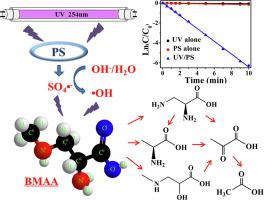Chemical Engineering Journal ( IF 13.3 ) Pub Date : 2020-09-19 , DOI: 10.1016/j.cej.2020.127041 Boyin Yan , DongChuan Xu , Zhiquan Liu , Jiangzhou Tang , Rui Huang , Min Zhang , Fuyi Cui , Wenxin Shi , Chun Hu

|
In this study, the degradation of β-N-methylamino -L-alanine (BMAA; a novel neurotoxin produced by cyanobacteria) in the UV254/persulfate (PS) system was investigated. The degradation of BMAA satisfied the pseudo-first-order kinetic model. Moreover, the effects of reaction parameters (PS concentration, BMAA concentration, and pH) and water matrix (natural organic matter (NOM) and some anions) were evaluated. The second-order rate constants between BMAA and SO4•- or •OH at pH 7 were 4.75×10 9 M -1·s -1 and 5.49×10 9 M -1·s -1, respectively, as measured by a competition kinetics experiment. The results of the steady-state kinetics model and scavenging experiments indicated that SO4-• was the major radical contributing to BMAA degradation in the UV254/PS system. Moreover, pH significantly affected the degradation rate of BMAA, and the highest rate was obtained at pH 8 with a pseudo-first-order rate constant (kobs) of 1.039 min-1. However, the degradation of BMAA was inhibited in aqueous solution due to the influence of the water matrix. The kobs decreased in the presence of NOM and chloride ions (Cl-) and increased in the presence of bicarbonate (HCO3-). Given that the degradation rate of total organic carbon (TOC) was lower than that of BMAA, the transformation products and a possible degradation pathway were investigated. The C-N bond on BMAA may be attacked by radicals, and BMAA may be transformed into 2,3-diaminopropionic acid or L-alanine. Moreover, BMAA could also be converted to 2-hydroxy-3-methylamino propanoic acid through hydroxylation. Three different BMAA transformants were further oxidized to generate pyruvic acid, after which decarboxylation leads to the formation of acetic acid from pyruvate.
中文翻译:

UV 254活化过硫酸盐降解神经毒素β-N-甲基氨基-L-丙氨酸的动力学模型和反应途径
在这项研究中,研究了β-N-甲基氨基-L-丙氨酸(BMAA;由蓝细菌产生的新型神经毒素)在UV 254 /过硫酸盐(PS)系统中的降解。BMAA的降解满足伪一级动力学模型。此外,评估了反应参数(PS浓度,BMAA浓度和pH)和水基质(天然有机物(NOM)和一些阴离子)的影响。pH值为7时BMAA与SO 4 • -或•OH之间的二级速率常数为4.75×10 9 M -1 ·s -1和5.49×10 9 M -1 ·s -1分别由竞争动力学实验测得。稳态动力学模型和清除实验的结果表明,SO 4 - •是BMAA降解的主要贡献自由基在UV 254 / PS体系。此外,pH值显着影响BMAA的降解速率,在pH值为8时以1.003 min -1的拟一级速率常数(k obs)获得了最高速率。但是,由于水基质的影响,在水溶液中抑制了BMAA的降解。所述ķ OBS在NOM和氯离子(CL的存在降低- )和碳酸氢盐的存在下增加(HCO 3-)。考虑到总有机碳(TOC)的降解率低于BMAA,研究了转化产物和可能的降解途径。BMAA上的CN键可能受到自由基的攻击,并且BMAA可能被转化为2,3-二氨基丙酸或L-丙氨酸。此外,BMAA还可以通过羟基化转化为2-羟基-3-甲基氨基丙酸。将三种不同的BMAA转化子进一步氧化生成丙酮酸,然后脱羧导致丙酮酸形成乙酸。











































 京公网安备 11010802027423号
京公网安备 11010802027423号